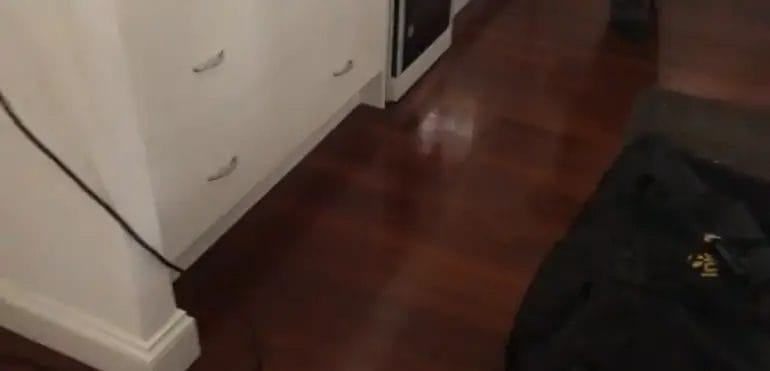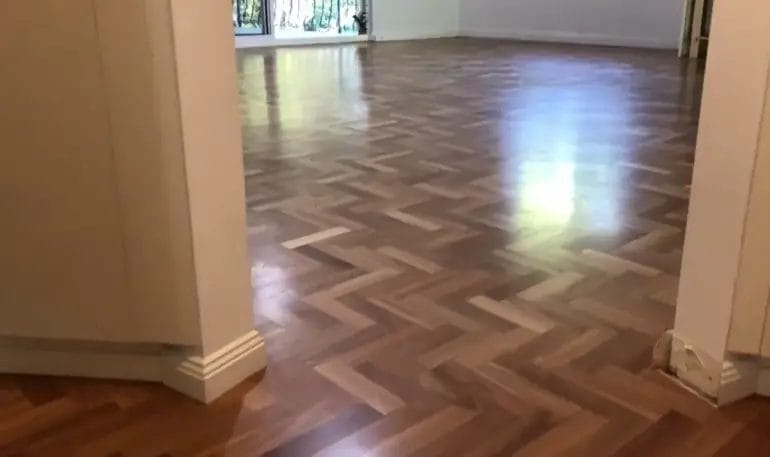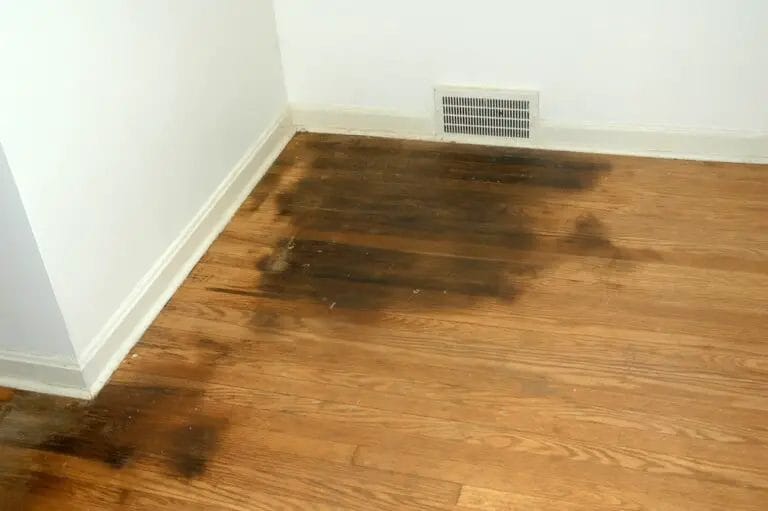If you’re dealing with moisture trapped in your wood floors, it’s important to address the issue promptly to prevent further damage.
Drawing out moisture from wood floors requires a combination of time, patience, and the right techniques.

One effective method is to use a dehumidifier in the affected area to reduce the overall humidity levels.
You can also place fans strategically around the damp area to promote air circulation and speed up the drying process.
If the moisture problem persists, it may be necessary to consult a professional who specializes in wood floor restoration to prevent any long-term consequences.
Remember, taking immediate action is crucial to restoring the beauty and integrity of your wood floors.

Signs and Symptoms of Moisture Damage in Wood Floors
Wood floors can add a touch of elegance and warmth to any space. However, they are also susceptible to moisture damage, which can be a cause for concern. Moisture damage in wood floors not only affects their appearance but can also compromise their structural integrity. It is important to be aware of the signs and symptoms of moisture damage in wood floors so that you can take prompt action to mitigate the issue.
1. Cupping
Cupping is one of the most common signs of moisture damage in wood floors. It occurs when the edges of the floorboards start to curl or lift, giving the floor a concave appearance. Cupping is usually a result of excess moisture absorbed by the wood, causing it to swell and deform. If you notice that your wood floorboards are cupping, it is a clear indication of moisture damage.
2. Crowning
Crowning is the opposite of cupping and refers to when the center of the floorboard becomes higher than the edges. This can also be caused by moisture-related issues. When excess moisture is present, the wood in the center of the floorboard absorbs more moisture than the edges, leading to crowning. It is important to address crowning as it can indicate the presence of moisture damage.
3. Buckling
If your wood floor begins to buckle or warp, it is a sign of severe moisture damage. Buckling occurs when the wood expands and contracts due to changes in moisture levels. The excessive swelling can cause the floorboards to lift and separate from the subfloor. This not only affects the appearance of the floor but also poses a tripping hazard. Immediate action is necessary to prevent further damage.
4. Discoloration
Moisture damage can lead to visible discoloration of wood floors. When excess moisture is present, it can seep into the wood, causing it to darken or stain. This discoloration is often uneven and can be a sign of underlying moisture issues. If you notice patches of discoloration on your wood floor, it is important to investigate the cause and address it promptly.
5. Foul Odor
Moisture damage can also result in a foul odor emanating from your wood floors. When water or moisture becomes trapped in the wood, it creates a breeding ground for mold and mildew. These microorganisms can release unpleasant odors, indicating the presence of moisture damage. If you detect a musty or damp smell coming from your wood floors, it is crucial to take action to prevent further damage and potential health hazards.
6. Squeaky or Loose Floorboards
Excess moisture can cause wood floorboards to swell and shift, leading to squeaky or loose floors. When moisture damage occurs, the wood can lose its structural integrity, resulting in uneven or unstable flooring. If you notice that your wood floors are squeaking or the floorboards feel loose, it may be a sign of moisture damage.
In summary, being aware of the signs and symptoms of moisture damage in wood floors is essential for maintaining the longevity and beauty of your flooring. Cupping, crowning, buckling, discoloration, foul odors, and squeaky or loose floorboards are all indications of potential moisture issues. If you observe any of these signs, it is important to investigate the cause and take appropriate measures to address the moisture damage. Seeking professional assistance can help you identify the root cause and implement effective solutions to protect and restore your wood floors.

Preventive Measures to Avoid Moisture Build-up in Wood Floors
Wood floors add beauty and warmth to any home, but they can also be susceptible to moisture damage. Excessive moisture can cause wood floors to warp, buckle, or develop mold and mildew. To protect your investment and maintain the longevity of your wood floors, it is important to take preventive measures to avoid moisture build-up. In this section, we will discuss some effective methods to keep your wood floors dry and free from moisture-related issues.
1. Install Vapor Barriers
A vapor barrier is a material that prevents moisture from seeping through the subfloor and reaching the wood flooring. Installing a vapor barrier between the subfloor and the wood flooring can effectively block moisture from entering the floorboards. Plastic sheeting or specialized vapor barrier materials can be used for this purpose. Make sure to seal any seams or joints properly to create a tight barrier.
2. Maintain Proper Ventilation
Poor ventilation can lead to moisture accumulation in the air, which can seep into the wood flooring. Ensure that your home has proper ventilation by installing vents, exhaust fans, or dehumidifiers in areas prone to moisture, such as bathrooms, kitchens, and basements. Good air circulation can help reduce humidity levels and prevent moisture from affecting your wood floors.
3. Control Humidity Levels
Wood floors are sensitive to changes in humidity levels. High humidity can cause the wood to swell, while low humidity can cause it to shrink and crack. It is important to maintain a consistent humidity level in your home to prevent moisture-related issues. Use a hygrometer to measure the humidity levels and keep them between 40% and 60%. Consider using a humidifier or dehumidifier to regulate humidity levels as needed.
4. Clean Spills and Moisture Promptly
Accidents happen, and spills on wood floors are inevitable. However, it is crucial to clean up spills and any other sources of moisture as soon as possible to prevent water from seeping into the wood. Use a soft, absorbent cloth or mop to blot up spills and dry the area thoroughly. Avoid using excessive water or harsh cleaning products that can damage the wood or strip away its protective finish.
5. Use Area Rugs and Mats
Placing area rugs or mats in high-traffic areas, entryways, or areas prone to moisture can help protect your wood floors from potential damage. These rugs or mats can act as a barrier, absorbing excess moisture and preventing it from reaching the wood. Make sure to choose rugs with a non-slip backing to prevent accidents and regularly clean and dry them to avoid trapping moisture underneath.
6. Regularly Inspect and Maintain Your Wood Floors
To prevent moisture build-up and avoid any potential damage to your wood floors, it is essential to perform regular inspections and maintenance. Look for signs of moisture, such as warping, cupping, or discoloration, and address them promptly. Maintain a regular cleaning routine and use appropriate wood floor cleaners recommended by the manufacturer. Additionally, periodically check the condition of the sealant or finish and reapply as needed to keep the wood protected.
7. Monitor the Exterior Drainage
Water can also enter your home through improper exterior drainage, leading to moisture issues in the wood floors. Ensure that your gutters, downspouts, and landscaping slope away from your home’s foundation to prevent water from pooling near the structure. Regularly inspect and address any drainage issues to avoid excess moisture infiltration.
In summary, taking preventive measures to avoid moisture build-up in wood floors is crucial for maintaining their beauty and durability. Installing vapor barriers, maintaining proper ventilation, controlling humidity levels, promptly cleaning spills, using area rugs and mats, regularly inspecting and maintaining the floors, and monitoring exterior drainage are effective ways to keep your wood floors dry and free from moisture-related damage. By implementing these preventive measures, you can enjoy the timeless elegance of your wood floors for years to come.

Effective Methods to Draw Moisture Out of Wood Floors
Wood floors can add warmth and beauty to any home, but they are also susceptible to moisture damage. Excessive moisture can cause the wood to warp, buckle, and even rot over time. It’s important to address moisture issues promptly to prevent further damage and maintain the integrity of your wood floors. In this section, we will explore some effective methods to draw moisture out of wood floors.
1. Identify the Source of Moisture
Before you can effectively address moisture issues in your wood floors, it’s essential to identify the source of the moisture. Common sources include leaks in plumbing, poor ventilation, or excessive humidity levels. By identifying and fixing the source of the moisture, you can prevent further damage and ensure the effectiveness of any moisture-reducing methods you employ.
2. Increase Air Circulation
Improving air circulation in the affected area can help draw out moisture from the wood floors. Open windows and doors to allow fresh air to circulate. You can also use fans or dehumidifiers to increase airflow and reduce humidity levels. This method is particularly effective in areas with high humidity or where the moisture is caused by poor ventilation.
3. Utilize Desiccants
Desiccants are substances that can absorb moisture from the surroundings. Silica gel, activated charcoal, or even uncooked rice are commonly used desiccants. Place the desiccants in breathable containers and distribute them around the affected area. The desiccants will absorb the excess moisture from the wood floors effectively.
4. Apply Heat
Heat can help accelerate the evaporation process and draw moisture out of wood floors. You can use portable heaters or heat lamps to warm the affected area. Ensure proper ventilation during the process to prevent the buildup of humidity. It’s important to be cautious when using heat, as excessive heat can damage the wood or even start a fire.
5. Use a Dehumidifier
A dehumidifier is an effective tool for reducing moisture levels in a room. It works by removing excess moisture from the air, thus aiding in drying out the wood floors. Place the dehumidifier in the affected area and adjust it to the appropriate moisture level. Regularly empty the water collection tank to maintain its effectiveness.
6. Sand and Refinish the Wood Floors
If your wood floors have been severely damaged by moisture and are showing signs of warping or buckling, you may need to resort to sanding and refinishing. Sanding removes the damaged layers of wood, while refinishing restores the floors to their original condition. This process can effectively eliminate any remaining moisture and restore the beauty of your wood floors.
7. Consult a Professional
If you are unsure about how to effectively remove moisture from your wood floors or if the damage is extensive, it’s always best to consult a professional. They have the knowledge, experience, and necessary equipment to assess the situation accurately and provide appropriate solutions.
In summary, addressing moisture issues promptly is crucial to prevent further damage to wood floors. By identifying the source of moisture and employing effective methods such as increasing air circulation, utilizing desiccants, applying heat, using a dehumidifier, or seeking professional assistance, you can successfully draw out moisture and restore the integrity of your wood floors.
Professional Solutions for Removing Excess Moisture from Wood Floors
Excess moisture on wood floors can lead to various problems, such as warping, buckling, and mold growth. It is important to address this issue promptly to prevent any further damage to your precious wood flooring.
In this section, we will explore some professional solutions that can effectively remove excess moisture from wood floors, ensuring their longevity and maintaining their pristine condition.
1. Identify the Source of Moisture
The first step in resolving the issue of excess moisture is to identify the source. This could be a plumbing leak, high humidity in the environment, or even improper ventilation. Once you have determined the source, it becomes easier to tackle the problem.
2. Use Dehumidifiers
Dehumidifiers are excellent tools for reducing the overall humidity in a room or space. These devices work by extracting moisture from the air, thus preventing further damage to your wood floors. Place dehumidifiers strategically in the affected area to ensure maximum effectiveness.
3. Install a Moisture Barrier
A moisture barrier, such as a vapor barrier or a moisture-resistant underlayment, can be installed between the subfloor and the wood flooring. This barrier helps to block moisture from seeping into the wood, providing an added layer of protection.
4. Utilize Fans and Proper Ventilation
Circulating air can help expedite the drying process. Use fans to increase airflow in the affected area. Additionally, ensure proper ventilation by opening windows and doors or using exhaust fans. This will aid in drying out the wood floors and preventing further moisture buildup.
5. Employ Professional Water Extraction Techniques
In severe cases of excess moisture, it may be necessary to employ professional water extraction techniques. This involves using specialized equipment, such as moisture meters and powerful vacuum systems, to effectively remove the moisture from the wood floors.
6. Seek Professional Assistance
If you are unsure about how to handle the excess moisture issue on your wood floors or if the problem persists despite your efforts, it is advisable to seek professional assistance. Professional flooring experts have the knowledge, experience, and tools to accurately diagnose the problem and provide appropriate solutions.
7. Take Preventive Measures
Prevention is always better than dealing with moisture issues after they occur. To avoid excess moisture on wood floors in the future, make sure to mop up spills immediately, maintain proper humidity levels in your home, and use area rugs or mats in high traffic areas.
8. Regular Maintenance and Inspection
Regular maintenance and inspection of your wood floors are crucial for early detection of any moisture-related problems. Inspect your floors for signs of warping, cupping, or discoloration. If you notice any issues, address them promptly to prevent further damage.
In summary, excess moisture can cause significant damage to wood floors. It is essential to identify the source of moisture and take proactive measures to remove it. Utilize dehumidifiers, install moisture barriers, and promote proper ventilation. Seek professional assistance if needed and implement preventive measures to avoid future moisture issues. Regular maintenance and inspection are key to preserving the beauty and integrity of your wood floors.
FAQs
1. How can I draw moisture out of wood floors?
To draw moisture out of wood floors, you can use a dehumidifier or fans to increase air circulation and reduce humidity levels. Additionally, placing absorbent materials like towels or kitty litter on the damp areas can help absorb excess moisture. It is important to address the source of moisture to prevent further damage to the wood floors.
2. Can baking soda help in drawing moisture out of wood floors?
Baking soda is not specifically designed to draw moisture out of wood floors. While it may help absorb some moisture, it is recommended to use more effective methods like using a dehumidifier, fans, or absorbent materials to address the moisture issue in wood floors.
3. How long does it take to draw moisture out of wood floors?
The time it takes to draw moisture out of wood floors depends on various factors such as the extent of moisture damage, the type of wood, and the environmental conditions. It can take several days to weeks for moisture to fully evaporate. It is important to monitor the progress and ensure proper ventilation to speed up the drying process.
Conclusion
In conclusion, drawing moisture out of wood floors is a crucial step in preventing damage and maintaining their longevity. By following the steps mentioned in this guide, including using moisture meters, dehumidifiers, and ventilation, you can effectively remove excess moisture and prevent further issues such as warping, buckling, or mold growth.
Remember to regularly inspect your wood floors for any signs of moisture or damage and take prompt action to address them. Additionally, maintaining a consistent indoor humidity level and practicing preventative measures, such as wiping up spills promptly and using area rugs in high traffic areas, can help in preventing excess moisture in the first place.
By taking proper care of your wood floors and implementing these moisture removal techniques, you can ensure that they remain beautiful, durable, and last for many years to come.